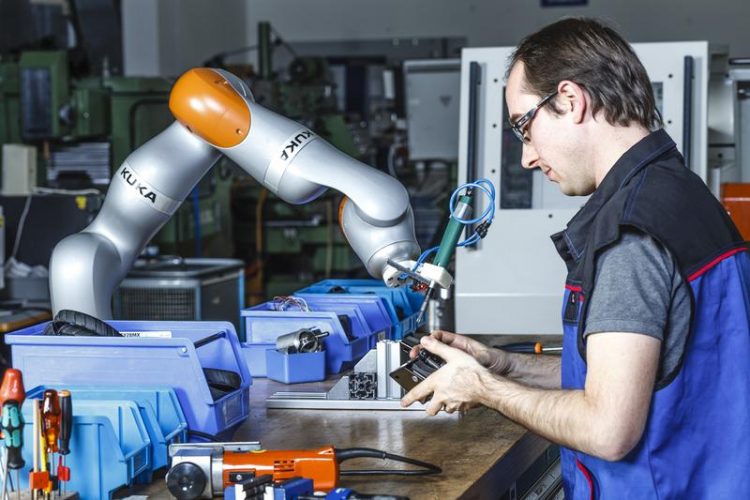Human-robot interaction: sensor-controlled assembly

Sensor-controlled assembly. Image credit: Fraunhofer IPA
The focus is on effective human-robot interaction at a workstation similar to those on a shop floor, the goal being to enable the worker to easily program the robot and use it intuitively like a tool.
Growing cost pressure, short product life cycles and high product diversity call for flexible and cost-effective assembly systems that can be quickly adapted to suit changed requirements. Scientists at Fraunhofer IPA have developed a sensor-controlled assembly process that makes it possible for workpieces to be localized and positioned.
Work-holding fixtures are extensively replaced by sensors, this offering flexibility at low cost. Other advantages are that the robot is designed to be easily programmable and capable of dealing with tolerances.
Using a robot as a tool
“Our aim is to demonstrate that sensor-controlled robots are capable of coping with modern-day conditions at manual assembly workstations, such as chaotically arranged components,” says Martin Naumann, Group Leader in the Robot and Assistance Systems department at Fraunhofer IPA. The emphasis is on effective human-robot interaction. Selected assembly processes are carried out manually, while others are automated. The robot is intended to be used as a tool.
At the joint stand of the European research initiative SMErobotics, Fraunhofer IPA will demonstrate sensor-controlled assembly in a robot cell with the KUKA LBR iiwa. “At a manual workstation, we’ll use the lightweight robot to carry out riveting processes as an example.
However, the underlying concepts can equally well be applied to other assembly processes,” explains Naumann. The components are made available within the robot’s working area without the need for any separate work-holding fixture.
The robot moves to the determined location and localizes the exact riveting position on the component using a stereo camera integrated in the robotic tool. “We’re highly interested in transferring the exhibited solution to new applications – especially at small and medium-sized manufacturing enterprises, where manual work processes prevail,” says Naumann.
More at Automatica – 6th International Trade Fair for Automation and Mechatronics
3 to 6 June 2014
New Trade Fair Centre Munich
Hall A4 | Stand 131
http://www.automatica-munich.com
http://www.ipa.fraunhofer.de
Media Contact
All latest news from the category: Power and Electrical Engineering
This topic covers issues related to energy generation, conversion, transportation and consumption and how the industry is addressing the challenge of energy efficiency in general.
innovations-report provides in-depth and informative reports and articles on subjects ranging from wind energy, fuel cell technology, solar energy, geothermal energy, petroleum, gas, nuclear engineering, alternative energy and energy efficiency to fusion, hydrogen and superconductor technologies.
Newest articles

A universal framework for spatial biology
SpatialData is a freely accessible tool to unify and integrate data from different omics technologies accounting for spatial information, which can provide holistic insights into health and disease. Biological processes…

How complex biological processes arise
A $20 million grant from the U.S. National Science Foundation (NSF) will support the establishment and operation of the National Synthesis Center for Emergence in the Molecular and Cellular Sciences (NCEMS) at…

Airborne single-photon lidar system achieves high-resolution 3D imaging
Compact, low-power system opens doors for photon-efficient drone and satellite-based environmental monitoring and mapping. Researchers have developed a compact and lightweight single-photon airborne lidar system that can acquire high-resolution 3D…





















